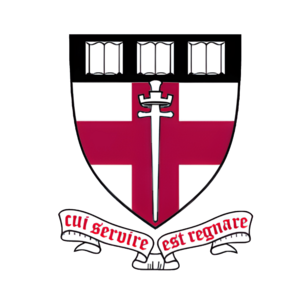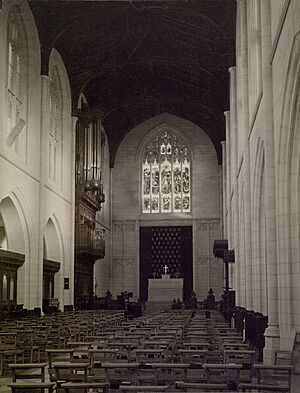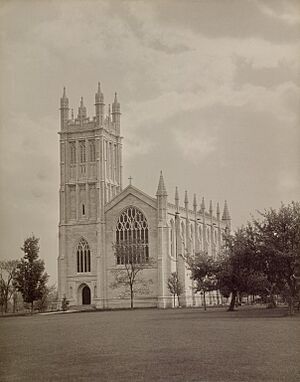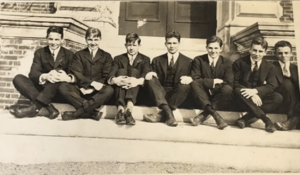Groton School facts for kids
Quick facts for kids Groton School |
|
|---|---|
 |
|
| Address | |
|
282 Farmers Row
, Massachusetts
01450
United States
|
|
| Coordinates | 42°35′36″N 71°35′03″W / 42.59333°N 71.58417°W |
| Information | |
| Type | Private, day and boarding school |
| Motto | Cui servire est regnare ("In whose [God's] service is perfect freedom" / "To serve [God] is to reign") |
| Religious affiliation(s) | Episcopal Church |
| Established | 1884 |
| Founder | Endicott Peabody |
| Headmaster | Temba Maqubela |
| Grades | 8–12 |
| Gender | Coeducational |
| Enrollment | 378 (2023–24) |
| Campus type | rural |
| Color(s) | Crimson, white & black |
| Athletics | baseball, basketball, cross country, football, ice hockey, lacrosse, rowing, squash, soccer, swimming, track & field, tennis, volleyball |
| Athletics conference | Independent School League |
| Nickname | Zebras |
| Accreditation | NEASC |
| Endowment | $475 million |
| Tuition | Boarding: $60,895 Day: $47,420 |
Groton School is a private school in Groton, Massachusetts, USA. It helps students get ready for college. It is a day school, meaning some students go home after classes. It is also a boarding school, where other students live on campus. The school is connected to the Episcopal Church.
Groton has about 380 students, both boys and girls. They are in grades eight through twelve. These grades are called Forms II–VI, like in British schools. The school has a large fund of $475 million. This helps them offer financial aid to students who need it. About 40–44% of students receive financial help. Students from families earning under $150,000 can attend for free. In 2022, only 8% of students who applied were accepted. Famous people who went to Groton include U.S. President Franklin D. Roosevelt and Nobel Prize winner John B. Goodenough.
Contents
School History
Early Years: 1884–1940
Groton School was started in 1884 by Endicott Peabody. He was an Episcopal priest. Important people like Harvard president Charles Eliot and J. P. Morgan supported him. The Roosevelt family also helped, as Theodore Roosevelt was a friend of Peabody.
Peabody was the headmaster for 56 years. He believed in "muscular Christianity," which meant being strong in body and spirit. He set up a strict system for students. This included cold showers and small sleeping areas instead of private rooms. He wanted to make wealthy students tougher.
Under Peabody, Groton aimed to inspire students to serve the public. Many graduates worked in public service during peacetime. In wartime, this idea was even more important. In World War I, 475 out of 580 military-age alumni served. About 700 alumni served in World War II.
Peabody also wanted students to be ready for college. He started entrance exams and scholarships in 1907. This helped students like Henry Chauncey '23, who later helped make the Scholastic Aptitude Test popular. Peabody even helped some students pay for college.
Changes and Civil Rights: 1940–1965
John Crocker '18 became headmaster after Peabody. His time as headmaster saw the start of the Civil Rights Movement. In 1951, Groton accepted its first African-American student. In 1965, Crocker and 85 Groton students marched with Martin Luther King Jr. in Boston. Crocker also greatly increased financial aid. By 1965, about 30% of students received scholarships.
Girls Join Groton: 1965–1977
After Crocker, Groton had three headmasters in a short time. During these years, the school decided how to become co-educational. This meant allowing both boys and girls to attend. One plan was to merge with a girls' school, but that did not happen.
Eventually, the school decided to slowly add girls. Groton welcomed its first female students in 1975. After that, applications tripled. Today, the student body is split evenly between boys and girls. The new headmasters also made the school less strict. They replaced sleeping cubicles with real bedrooms. They also added more holidays and relaxed the dress code. Students got more free time on weekends. However, some traditions, like public service and connection to the Episcopal Church, remained.
Modern Groton: 1977–Present
Groton continued to grow under William Polk '58 (1978–2003) and Richard Commons (2003–13). They improved the campus buildings and brought in more international students. The current Headmaster is Temba Maqubela (2013–present) from South Africa. In recent years, Groton has focused on making school more affordable. Since 2008, Groton has offered free tuition to families with lower incomes. In 2014, the school started a fundraising campaign. This allowed them to admit students based on their abilities, not their family's income.
Members of the Groton community still play a big role in other schools. Many former Groton teachers are now heads of other well-known schools.
Academics and Reputation
School Rankings and Selectivity
In 2024, Niche ranked Groton as America's top private high school. However, rankings can change quickly for small schools. In 2020, Groton was ranked #33. The school's small size also helps it have low admission rates. In 2016, Business Insider called Groton the most selective boarding school in the U.S. Private School Review repeated this in 2024.
Learning and Test Scores
The average SAT score for the class of 2023 was 1490. Their average ACT score was 33.5. Groton has a 4:1 student-teacher ratio. This means there are only 4 students for every teacher. This allows for many courses and special study programs for older students. Groton students took many Advanced Placement (AP) exams. From 2018 to 2022, they passed 93% of them.
College Admissions
Groton has a history of sending many students to top universities. From 1906 to 1932, almost all Groton students who applied to Harvard College were accepted. This was partly because many colleges accepted most applicants back then. Also, Groton students often did well on college entrance exams.
Over time, college admissions became more competitive. Universities started looking for a wider range of students. They also focused more on raw academic talent. This meant fewer prep school graduates attended top universities. From 2019 to 2023, the most common colleges for Groton graduates included University of Chicago, Georgetown University, Yale University, and Harvard University.
Other Schools Groton Helped Start
Groton has helped create other schools.
- In 1909, Brent International School Baguio was founded in the Philippines. Its first headmaster was a former Groton teacher.
- In 1926, Peabody founded Brooks School in North Andover, Massachusetts. Groton was very popular, and Peabody did not want to make it bigger. So, he raised money to build a new school. Brooks School was also Episcopal and small, like Groton.
- Groton also supports Epiphany School. This is a free middle school in Boston for students who need extra support. Epiphany students even spend their summers on Groton's campus.
Admissions and Student Life
How to Get In
Groton's acceptance rate is usually around 12%. During the COVID-19 pandemic, applications increased. This made the acceptance rate drop to 9% in 2021 and 8% in 2022. Groton admits students based on their abilities, not their family's income. This means that students who need financial aid have the same chance of getting in as those who don't. In 2018, the school announced that the admission rate was the same for both groups.
Some students who get into Groton are siblings of current students. Others are children of school employees.
Grade Levels
At Groton, grades are called Forms. This term comes from the United Kingdom. In the 2023–24 school year, Groton had 377 students. This included 26 eighth graders (Second Formers) and 91 seniors (Sixth Formers).
Student Body
| Race and ethnicity | Groton | Massachusetts | ||
|---|---|---|---|---|
| White | 47.5% |
|
69.6% |
|
| Asian | 23.5% |
|
7.7% |
|
| Black | 8.7% |
|
9.5% |
|
| Hispanic | 12.9% |
|
13.1% |
|
| Multiracial | 7.4% |
|
2.7% |
|
When Groton started in 1884, most students were from wealthy, white families. They came from places like New York and New England. Schools like Groton believed their job was to teach good values to those who would become powerful.
In the 2023–24 school year, 46% of Groton students were students of color. About 15% of students traveled to school from nearby towns. Also, 7% of students were from other countries, coming from 25 different nations.
Finances
Tuition and Financial Aid
For the 2023–24 school year, boarding students paid $59,995. Day students paid $46,720. About 40–44% of students get financial aid. This aid covers, on average, $46,519 for boarding students. For day students, it covers $32,371. Since 2008, Groton has offered free tuition for families earning under a certain amount. In 2024, this amount was raised to $150,000. All financial aid is given as grants, which means students do not have to pay it back.
Groton tries to keep its tuition lower than other similar schools. In 2022, it was the least expensive among 40 boarding schools. However, other schools might offer more financial aid. So, the final cost for a student could be similar.
School's Funding
Groton has a large financial fund of $475 million. This helps the school operate. Groton is a private school, so it does not rely on government money. However, it can get some government help. For example, the state of Massachusetts has helped Groton get special bonds. These bonds help the school pay for new buildings or renovations.
Campus Life
School Grounds
Groton has a large 480-acre campus. It includes school buildings, dorms, sports fields, and natural areas. The campus was designed by Frederick Law Olmsted. He also designed Central Park in New York City. The main buildings are around a circular lawn called "The Circle." This area is a symbol of Groton's campus. In 2018, Architectural Digest called Groton the most beautiful private high school campus in Massachusetts.
The oldest buildings are around The Circle. They were designed by Peabody & Stearns between 1884 and 1902. These include Brooks House (a dorm), the Fives Court, Hundred House (another dorm), the Schoolhouse, and the old gym (now the dining hall). The Chapel was finished in 1900. The school has also added modern buildings. It built a solar battery farm and a special faculty home. These help the school use less energy.
The school has many sports facilities. These include an Athletic Center with hockey rinks, basketball courts, squash courts, and a swimming pool. There is also a boathouse on the Nashua River, a track, and tennis courts.
Spiritual Life
Chapel Services
St. John's Chapel opened in 1900. It was a gift from William Amory Gardner, one of the school's first teachers. The Chapel was designed by Henry Vaughan. He also designed the Washington National Cathedral. The Chapel is large because it served as both a school chapel and a local church.
Students at Groton must attend five religious services each week. Four are short services on weekday mornings. One is a longer service on the weekend. Students can choose which weekend service to attend. The school's services are simple, which helped attract students from different Christian backgrounds.
School Motto
Groton's motto is cui servire est regnare. It was adopted in 1902. This Latin phrase has two main English translations. One is "in whose [God's] service is perfect freedom." The other is "to serve [God] is to reign." The school accepts both meanings. The phrase comes from an ancient Christian saying.
Athletics
Groton's sports teams play in the Independent School League (ISL). This league includes other private schools in the Boston area. ISL schools do not offer sports scholarships. They also do not recruit students who have already graduated high school.
Sports Offered
Groton offers 47 teams in 22 different sports.
Fall Sports
- Cross country
- Field hockey (girls)
- Football (boys)
- Soccer
- Volleyball (girls)
Winter Sports
Spring Sports
- Baseball (boys)
- Rowing
- Lacrosse
- Tennis
- Track and field
The Groton football team has had many successful coaches. In 1905, Endicott Peabody convinced President Theodore Roosevelt to make football safer. This led to new rules, like the forward pass. The Groton football team won the ISL championship in 1997. Some alumni are currently playing college football.
The Groton boys' rowing team has won nine New England championships. Five of its members have won Olympic gold medals. The girls' rowing team has won four New England championships. Both teams often compete in big races like the Henley Royal Regatta.
The Groton girls' tennis team won the ISL championship in 2023 and 2024. The boys' tennis team won in 2018 and 2022. Both the boys' and girls' squash teams won national championships in 2020. Groton alumni have also won Olympic gold medals in sailing.
School Rivalries
Groton's main sports rival is St. Mark's School. They started playing each other in 1886. Their football rivalry is the fifth-oldest high school football rivalry in the U.S. The rivalry began when St. Mark's did not hire Endicott Peabody as headmaster.
Groton's rowing teams have competed against Noble and Greenough School since 1922. Groton also plays St. Paul's School in all sports for a trophy. They also play their neighbor Lawrence Academy in some sports.
Images for kids











